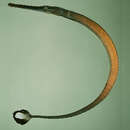ar
الأسماء في صفحات التنقل


Doryrhamphus janssi és una espècie de peix de la família dels singnàtids i de l'ordre dels singnatiformes.
És ovovivípar i el mascle transporta els ous en una bossa ventral, la qual es troba a sota de la cua.[6]
És un peix marí de clima tropical i associat als esculls de corall que viu entre 0-35 m de fondària.[4][7]
Es troba des del Golf de Tailàndia fins a Salomó, les Filipines,[8] Queensland (Austràlia)[9] i Micronèsia (Palau i Truk).[10][4] [11][12][13][14][15][16][17][18]
Doryrhamphus janssi és una espècie de peix de la família dels singnàtids i de l'ordre dels singnatiformes.
Doryrhamphus janssi, commonly known as the Janss' pipefish , is a species of pipefish belonging to the family Syngnathidae.
Doryrhamphus janssi has a long, slender body with an elongated, tubular mouth. It's a small sized fish which can reach a maximal length of 14 cm.[3] The body of this species is bright orange while the head and anterior portion of the trunk are blue. Its tail is flag-like with a black background color, white margin and white dot in the center.
The Janss' pipefish is found in the tropical waters of the central Indo-Pacific area, from Indonesia to the Philippines, this latter is the northern and eastern limit of the species distribution.[2] It likes sheltered inner reef and it is usually observed under small coral overhangs and crevices.[4]
Doryrhamphus janssi is a cleaner fish specialised in small fish like apogonids and damselfishes, they usually work in couple.[3]
It is ovoviviparous and like for the seahorse, the male carries the eggs in a brood pouch.[4]
The Janss' Pipefish is not easily kept because of to its unusual feeding requirements. This fish generally prefers to eat only live copepods.[5]
The specific name honours Edwin Janns Jr., a Los Angeles property developer who had a keen interest in marine biology.[6]
Doryrhamphus janssi, commonly known as the Janss' pipefish , is a species of pipefish belonging to the family Syngnathidae.
Doryrhamphus janssi es una especie de pez de la familia Syngnathidae, en el orden de los Syngnathiformes.
Tienen la boca en forma de tubo, ensanchando algo la cabeza y el cuerpo, que conforman una horizontal, rematada por una distintiva aleta caudal, más grande y ovalada. El cuerpo es color azul grisáceo, con una amplia zona central de color naranja, y la aleta caudal de color negro, con los márgenes y una mancha central en blanco.[2]
• Tiene 22-25 radios blandos dorsales, 19-21 radios blandos pectorales, 4 radios blandos anales, 16 anillos en el cuerpo y 21-23 anillos en la cola.[3]
• Los machos tienen una bolsa incubadora bajo el abdomen, y las hembras tienen ovopositor.
• Los machos pueden alcanzar 14 cm de longitud total.[4][5]
Es ovovivíparo y el macho transporta los huevos en una bolsa ventral, la cual se encuentra debajo de la cola.[6]
Tienen entre 80 y 150 huevos por camada, de color ámbar y con forma de pera, que están embebidos parcialmente en un trozo de piel, en el que los embriones reciben oxígeno de los capilares circundantes.[7] El macho incuba la puesta, hasta que eclosionan individuos perfectamente formados, transparentes, de unos 30 mm, que permanecen por poco tiempo en estado pelágico. Cuando se asientan comienza a aparecer la coloración.[2]
Es un pez de mar y de clima tropical y asociado a los arrecifes de coral que vive entre 0-35 m de profundidad.[8]
Se encuentra en piscinas mareales y grietas de los arrecifes, también en arrecifes interiores protegidos, normalmente en cuevas con esponjas y bajo grandes placas de corales.[4]
Es un activo limpiador, y sus estaciones de limpieza son visitadas por peces cardenal y damiselas, que son desparasitados por parejas de D. janssi.[2]
Se encuentra desde el este del océano Índico hasta las Islas Salomón, y Truk en Micronesia.
Es especie nativa de Australia, Camboya, Filipinas, India (Andaman), Indonesia, isla Navidad, Micronesia, Palaos, Papúa Nueva Guinea, Singapur, islas Salomón, Tailandia y Vietnam.[9]
Doryrhamphus janssi es una especie de pez de la familia Syngnathidae, en el orden de los Syngnathiformes.
Doryrhamphus janssi Doryrhamphus generoko animalia da. Arrainen barruko Syngnathidae familian sailkatzen da.
Doryrhamphus janssi Doryrhamphus generoko animalia da. Arrainen barruko Syngnathidae familian sailkatzen da.
Doryrhamphus janssi, communément nommé poisson-aiguille de Janss, est une espèce de poissons osseux de la famille des Syngnathidae.
Le poisson-aiguille de Janss est un poisson de petite taille, il peut atteindre une longueur maximale de 14 cm[2]. Il possède un corps effilé ainsi qu'un museau relativement long. Sa livrée caractéristique le rend aisément reconnaissable, son corps est en général bleu-ciel à bleu sombre à ses extrémités et le centre du corps est orange vif. Sa nageoire caudale est en forme d'éventail, elle est de teinte noire avec une tache blanche au centre et un liseré blanc sur le pourtour extérieur.
Le poisson-aiguille de Janns se rencontre dans les eaux tropicales de la partie centrale de la zone Indo-Pacifique soit entre l'Indonésie et les Philippines, qui représentent la limite nord et est de la zone de sa zone de répartition[3]. Son habitat correspond à des zones abritées comme sous de petits surplombs ou des crevasses[4].
Doryrhamphus janssi est un poisson nettoyeur spécialisé dans le déparasitage de petits poissons comme les membres de la famille des apogons et des demoiselles, il vit et œuvre en couple[2]. Il est ovovivipare et comme chez son proche cousin l'hippocampe, c'est le mâle qui porte les œufs durant la période d'incubation[4].
Doryrhamphus janssi, communément nommé poisson-aiguille de Janss, est une espèce de poissons osseux de la famille des Syngnathidae.
Doryrhamphus janssi is een straalvinnige vissensoort uit de familie van zeenaalden en zeepaardjes (Syngnathidae).[2] De wetenschappelijke naam van de soort is voor het eerst geldig gepubliceerd in 1972 door Herald & Randall.
De soort staat op de Rode Lijst van de IUCN als niet bedreigd, beoordelingsjaar 2009.[1]
Bronnen, noten en/of referenties強氏矛吻海龍(学名:Doryrhamphus janssi),为輻鰭魚綱棘背魚目海龍科的其中一種,分布於中西太平洋區,包括柬埔寨、越南、泰國、聖誕島、新加坡、菲律賓、澳洲、密克羅尼西亞、索羅門群島、帛琉及巴布亞紐幾內亞等海域,棲息深度可達35公尺,體長可達14公分,棲息在珊瑚礁縫隙及潮池,卵胎生。